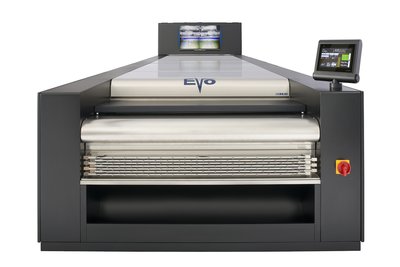Reproflex Scandinavia, in Denmark, is the first site in Europe to have the Evo 5 plate processor from Vianord installed
Vianord, a new start up venture based near Nice in France, is making rapid progress towards its declared aim of providing ‘automation with modularity’ for the flexo industry. Nick Coombes reports from the Côte d’Azur.
Now well established in its modern high-tech headquarters in Carros, the team of leading industry specialists at Vianord are developing a range of pre-press technology that, according to company spokesman Matteo Pecar, ‘will revolutionise the way flexo plates are made, and set a new quality benchmark within the global industry for consistent performance.’
The project, which has been named ‘Easy to Plate’, encompasses new designs for exposure units, plate processors, dryers and light finishers for photopolymer flexo and letterpress plates. The small size units have an ‘All-in-One’ concept, while the larger units are based on a modular system that allows each unit to be added as required, with the intention of creating a fully automated line. Design is a key element in the development of the technology, with the internationally renowned Albatech Monaco company engaged in creating the external appearance of the suite of machines, and the vast technical expertise of the ‘dream team’ of flexo experts, who own and run the company, taking care of the inner workings.
Four step plan
The machines are all labelled ‘Evo’ (short for Evolution) with a number attached according to the size of plates being manufactured. So, Evo 2 is capable of producing plates up to 660 x 860 mm, Evo 3 is for sizes up to 920 x 1200 mm, Evo 4 is 1200 x 1600 mm and the largest, Evo 5 is capable of plates to 1320 x 2030 mm. Already, several versions of the compact Evo 2A (‘A’ for ‘All-in-One’) and Evo 5 models have been manufactured and installed, and an Evo 2A was exhibited at the Labelexpo in Brussels.
‘Our plan is to introduce the ‘Easy to Plate’ full line capability in four stages, or steps,’ explained Mr Pecar. ‘Step 1 consists of a processor and an inline automatic eight-drawer dryer. This is already available and has been tested and ordered by customers. The processor can also be delivered as standalone unit, but is designed to allow the automatic dryer to be added at a later date. Step 2, which adds the light finishing section and a stacker, will be available before the end of this year. Step 3, which will include an inline LED exposure unit, will follow in mid 2014, and we expect to have Step 4, which adds a laser imaging unit and a punch and auto-feed facility shortly thereafter.’

Matteo Pecar
Streamlining
The aim is to streamline the whole process, with as little handling of the plate as possible, to avoid damage. In the event of fault in the equipment occurring, Vianord has created a unique component ID for each part, which, combined with online monitoring, provides the user with predicted life cycle data and allows preventative maintenance to be carried out during quieter production periods.
The Evo series includes an automatic integrated plate punch – this is a first for the industry, and typifies the creative thinking that underpins the design of the new series – it’s simple and it works! There are two types of processor, batch and incremental. Both can be attached to an automatic dryer, either at the time of installation or as a retrofit. This is the benefit of the modular system.
The processor unit has a separate pre-wash for digital plates with black (LAMS) layer running like a flow line. This is an industry first on the compact Evo 2, and is available on all sizes. The units have a new type of cooled bed that significantly improves their efficiency over other technology available on the market. It uses circulating water that maintains a constant temperature, without any time limit. Analogue plates have a vacuum system for exposure. The unit has a temperature probe, aircooled high-powered UV lamps, a light integrator, and fibre optic lamp control.
Sensitive control
The washout section has a new feature. Its step motor (servo drive) allows a soft start with progressive adjustment of the oscillating and rotating brushes that is governed by the speed of the plate. This provides a degree of consistency previously unattainable across a variety of plates and thicknesses, and the controllability allows different production plants to match plates for consistent performance. The unit’s new volumetric pump provides high precision solid content analysis, and a very sensitive pressure sensor gives precise control of the polymer volume.
To monitor the internal workings, a visual system known as ‘live process control’ is fitted to the dryer. This consists of a large screen with four separate images that correspond to micro cameras installed inside the machine. Two are located at the processor exit, to monitor the plate coming out and examine its surface, and two more are positioned on the plate transfer system, to show the sensitive mechanism that controls the transfer of the plate to the dryer.
‘Plate transfer is a crucial part of the inline process,’ explained Mr Pecar. ‘Although it may appear simple, the timing and mechanics have to be perfect. The cameras allow the operator to see this on the monitor, which also records the live image. This is important in the event of an error occurring, because it provides traceability. The advantage to the customer is that they can see the plate and the mechanism without the need to open the cover panels, and the pictures can be fed direct to Vianord for analysis. This feature is new and unique on the world market,’ he added.
The dryer also has ‘intelligent plate transfer’, which includes automatic aligning and selection of the closest empty drawer available to avoid unnecessary movement and loss of time. The drawers are sealed to prevent fume leakage, and each one is monitored to provide the operator with detailed information of what is being stored. The unit’s automatic pre-heat system and the temperatures used, make for fast drying. Temperature uniformity is monitored and controlled by two separate control interfaces, and new high-speed air suction speeds up the process of plate drying. The light finishing section has automated control of UVA-UVC post exposure, either simultaneous, consecutive, or delayed, and the unit also features an aircooling system and fibre optic lamp control.
Revolutionising the industry
‘We have attracted a great deal of interest from the market, and a number of flexo printers have already visited our facility and placed orders for machines’ stated Mr Pecar. ‘They have all said that what we are offering will revolutionise flexo. That is an amazing compliment!’ Vianord’s new approach to technology, and the facility it offers converters to build up to a fully automated line, will significantly improve the speed and quality of plate making, and at the same time offer savings in waste material and labour costs.
According to the company, the new Evo systems are all designed to be low maintenance, and each of the important parts is easily accessible. Combine this with online monitoring and the component ID system, and a feeling of fundamental change in production practices begins to seem very real. ‘We know that new technology and innovative thinking often takes time to be accepted by the market – but the Evo system makes its own commercial case in payback terms, and that will be a deal clincher,’ said Mr Pecar.






